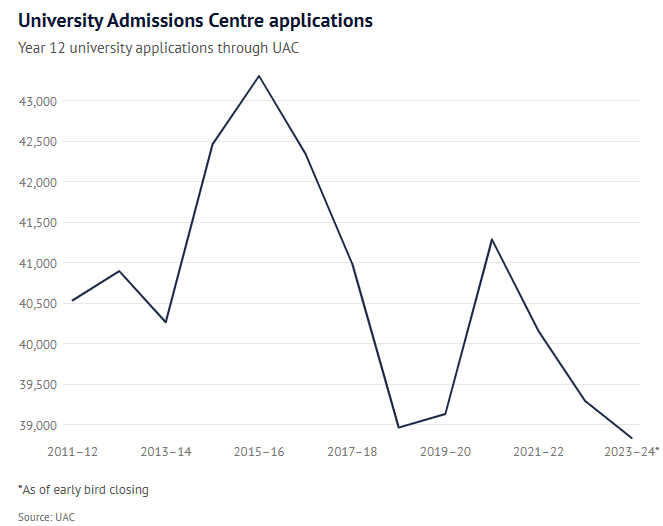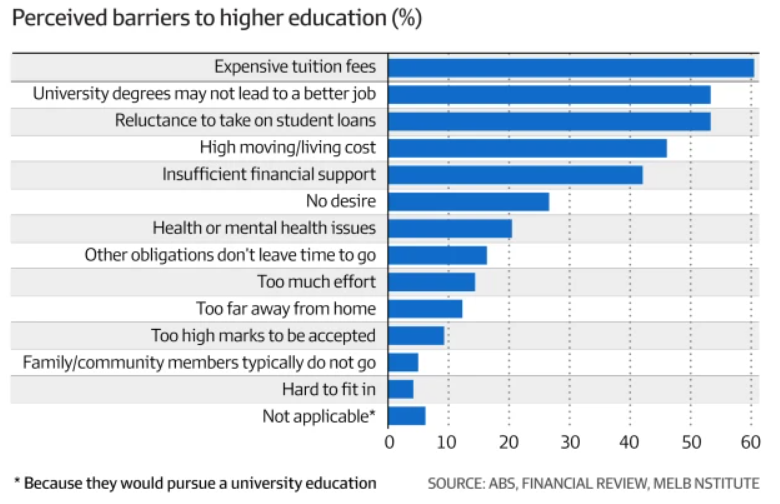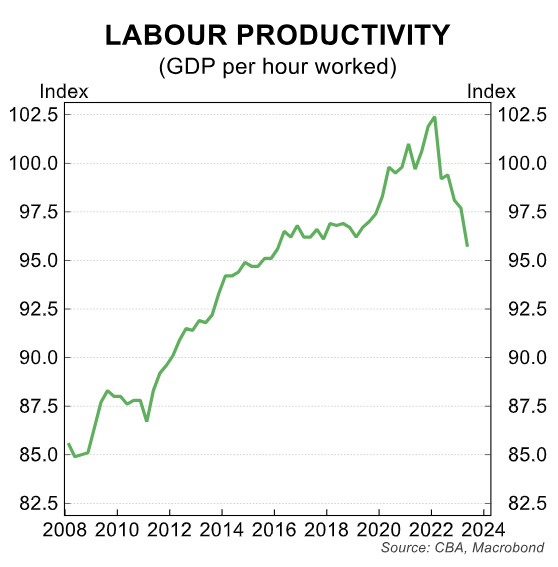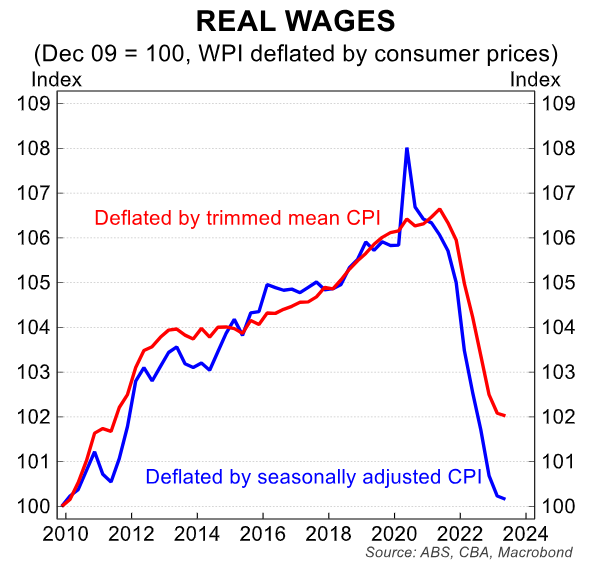Data from the Department of Education shows that there were 425,300 international students enrolled in Australian universities in the year to September 2023:

At the same time as international student enrolments are booming, domestic enrolment applications have collapsed to a decade low.
Year 12 applications to the University Admissions Centre have hit their lowest in over a decade, as appetite for further education decreases:

“Despite a larger cohort of HSC students, the number of all applications through the University Admissions Centre as of November dropped 2% compared to last year. The number of early offers through UAC fell about 10%”, The SMH reported in late December.
“Kim Paino, the general manager of marketing and engagement at UAC, said the high cost of living, stronger job market and increased costs of university degrees could all be contributing to the softening of demand”.
The AFR’s education editor, Julie Hare, chimed in on Tuesday with more analysis on the slump in domestic university enrolments:
“New students, largely made up of high-school leavers, fell to 267,110, from 290,900 in 2021, representing the smallest cohort since 2013, according to the latest data from the Department of Education”.
“The number of Australians studying a university course in 2022 fell to 1.1 million, down by 60,000 or 5.1 per cent, on the previous year, adding weight to fears that the nation’s young people are shunning degrees”.
“Andrew Norton, a higher education expert from Australian National University, said this trend was the first time since the 1950s that enrolments were going backwards”.
“In the 18- and 19-year-old age group, domestic commencing enrolments dropped 6.1 per cent between 2021 and 2022,” Mr Norton said.
“The new data also comes as a review of the university system has just landed on the desk of Education Minister Jason Clare, who has articulated a bold ambition to increase the proportion of young people with a degree to 55% by 2050, up from 45% today”.
I cannot blame young Australians for shunning university, given degrees have lost some of their value.
A study conducted by the Mackenzie Research Institute at the Holmesglen Institute in Melbourne showed that while university degrees aid in gaining employment, they do not guarantee success.
Although those holding a university education are more likely to hold the highest-paying and most prestigious jobs, their proportion of low-paying occupations is also growing.
This frequently leads in the displacement of persons with only diplomas and trade certificates, who replace those with little or no higher education.
Dr. Tom Karmel, former executive director of the National Centre for Vocational Education Research, said the findings called into question Australia’s “never-ending push” to expand the number of degree-holders.
“There’s no doubt that the occupations where people need degrees are growing faster than others, but the rate of credential growth has been so much greater than that”, he said.
“Credentials are becoming increasingly important even in lower paid jobs”.
“Is it skills deepening or is it really just blatant credentialism? It’s probably a bit of both. If everybody had a degree, a degree would be useless”, he said.
Dr. Karmel’s study drew on data from the 2011 and 2021 Australian censuses.
During that decade, the proportion of people with postgraduate degrees in the labour force rose from 5% to 9%, and the number of people with such degrees more than doubled, from around 500,000 to nearly 1.1 million.
Currently, around 3.1 million people possess undergraduate degrees, accounting for more than one quarter of the total Australian labour force.
In 2021, approximately 2% of labourers, machine operators, and technicians, 3% of salespeople, and 6% of clerical and administrative personnel held master’s or doctoral degrees.
Each of these fields has around four times as many people with bachelor’s degrees.
Under the Albanese government’s Universities Accord interim report, commissioned by Education Minister Jason Clare, over-credentialism would intensify.
The higher education attainment target outlined in this report is 55% by 2050. An additional 300,000 domestic undergraduate students are expected to enrol by 2035, with 900,000 by 2050.
However, judging by the numbers presented above, Australians are voting with their feet against these targets by shunning university.
“It makes me think that maybe we have reached peak higher eduction”, said Peter Hurley, director of the Mitchell Institute at Victoria University.
Meanwhile, enrolment in work-based training, such as apprenticeships, has increased dramatically in recent years.
According to data from its Taking the Pulse of the Nation survey, nearly 60% of participants stated that high tuition expenses were the biggest barrier to enrolling in university.
Shockingly, 52% of respondents believe that going to university will not lead to better employment opportunities, while the same proportion believes that having too much student debt is a barrier. These perceptions were shared equally by those with a degree and those who had never gone.

One of Australia’s most perplexing economic paradoxes is that, despite having a huge number of university graduates in the labour market, the country suffers from low productivity growth and “skills shortages” that never ease.

Real wage growth in Australia has similarly slowed as the number of university graduates has increased:

Why does the Albanese government want 55% of Australians between the ages of 25 and 44 to have a bachelor’s degree or higher?
The majority of jobs in Australia require a university degree, not because of any specific skill requirement or demand, but rather as a lazy “signalling” mechanism used by employers to filter job applicants.
This “credential inflation” has increased university enrolments while contributing little to the economy or society as a whole.
The value of a university degree has declined as the number of persons pursuing higher education has expanded to the point where too many people now hold a degree.
The current scenario is so ludicrous that a university degree is now required for entry-level professions that could previously be filled by someone with only a high school education.
Public financing has been redirected away from TAFE and vocational training, which have seen a drop in popularity. This has resulted in persistent skill shortages in a variety of industries, most notably the trades.
Universities have devolved into self-serving parasites driven by profit, graduating far too many students who would have been better served by a vocational program.
Australia’s emphasis in higher education must shift.
First and foremost, university admissions standards should be stricter for both domestic and overseas students. Governments should also expand VET and TAFE financing.
Prioritising universities above vocational training or trade schools was never in Australia’s best interests, socially or economically.
Labor’s 55% university attainment target must be abandoned.
In fact, Australia needs fewer individuals studying at universities and more people pursuing TAFE, VET, or apprenticeships.

